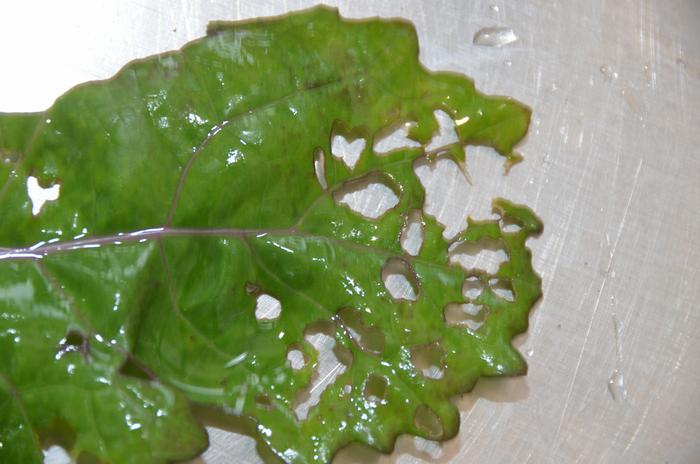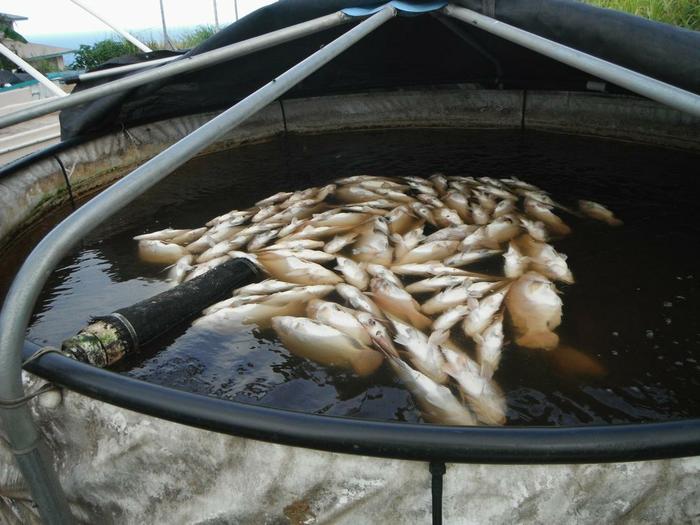How To Win The War On Bugs, Part 3 (or Aquaponic Pest Control)
Insects have lived on the planet Earth for about 350 million years, and have adapted to live just about everywhere, from the very hot to the ultra-cold. Insects have also found ways to turn just about everything into their home, including plants, animals, other insects, soil, water, snow, deserts, buildings, stored products, and people, and they’ve been just as creative in turning almost everything into food. And believe me, if we consider something edible, there are insects that do as well! Most insects are not pests, and are completely harmless, but some are a real problem when trying to grow food, as I was learning.
(Below) Not a disease (we’ll show you photos of those in a later Part of this series) not the result of a very small meteor shower, this is definitely bug damage on this leaf. 
Characteristics of Insects
Insects are invertebrates, which means they have no backbone or internal skeleton, but they do have an exoskeleton (internal skeleton), in the form of an outer hard shell. Their bodies are segmented with three major body regions: the head, thorax, and abdomen. Adults have two antennae, two compound eyes, six legs, and – if they have wings – they’ll have either two or four wings. They come in a huge variety of shapes, sizes, and functions. Insects are cold-blooded; unlike us mammals, their body temperature closely follows the temperature of their environment. Insects are different from mites, ticks, and spiders, all of which have only two major body sections, and four pairs of legs, and do not have antennae or compound eyes. Centipedes (ouch!) are also different than insects, with one pair of legs on each body segment, and millipedes have two pairs of legs on each body segment. Sow bugs are actually crustaceans, like crabs, shrimp, and lobster (yum!), and usually have seven pairs of legs…perhaps we should try sow bugs cooked with butter?
Insect Development
All insects develop from eggs. Most hatch after the egg is laid, but some, like the aphids, hatch within the female, and live young are produced. Aphids almost always female, and are effectively hatched already gravid (pregnant), and each one begins hatching tiny aphids very shortly after her own hatching, which is why they can multiply and take over so quickly in your aquaponics system – their population grows exponentially! There are three basic kinds of insect development from the egg to the mature adult insect:
- Simple, Gradual Metamorphosis – Metamorphosis is the change from the egg to adult stage. Eggs hatch and there is a gradual change as the immature forms, called nymphs, mature to the adult stage. Nymphs have compound eyes and antennae and resemble the adults but are smaller, without fully developed wings, and cannot reproduce. Wings of the adult develop externally, and there is no resting stage, as there is with a pupa. Nymphs usually live in the same habitat as the adults. Grasshoppers, cockroaches, and aphids have a gradual metamorphosis, which is why you see small ones that look just like the larger individuals.
- Incomplete and Complete Metamorphosis – Some insect have a metamorphosis that does not include a resting stage, but is not simple and gradual; it is referred to as “incomplete.” Dragonflies are an example of an incomplete metamorphosis: their nymphs live in water, have gills, and differ dramatically in appearance from the adults; they emerge from the water and molt into the adult form with wings, without a resting stage. Occasionally, you’ll find a dried out, light beige, ghost-like shell of what is about an inch and a half long fierce-looking insect, near the edge of your troughs or on a plant. It’s the left-behind shell of a dragonfly nymph, after it has crawled out of the water to molt into the adult dragonfly that we all easily recognize.
- Complete Metamorphosis – Immature stages are normally worm-like and are called larvae, and they feed a lot at this stage. The last larval stage is a resting stage called the pupa, which does not feed, usually is not active, and often is covered by a silken cocoon. Wings are developed internally, and when emerging, the adult expands the wings and flies off after they dry. Immature and adult stages are often quite different in form and live in very different habitats. Insects with complete metamorphosis include butterflies, flies, wasps, and beetles.
Pest Insects and Their Relationship to Plants
- Grasshoppers, beetles, caterpillars, and slugs chew on leaves, stem, fruit
- Aphids, leafhoppers, thrips, mites, whiteflies, and scales suck plant sap
- Caterpillars, root and twig borers, weevils, and leafminers bore and make tunnels
- Fruit flies and katydids lay eggs on plant tissue
- Gall wasps and erinose mites create galls on plants
- Cockroaches, whiteflies, ants, aphids, caterpillars contaminate crops with their waste
- Bagworms, leaf-cutter ants and leaf-cutter bees remove parts of plants for their nests or shelter
- Ants carry or protect pests (aphids in particular), and eat fruit and vegetable tissue
- Aphids, leafhoppers and ants transmit plant disease
Beneficial Insects and What They Provide
- Bees pollinate flowers that produce fruits, seeds, nuts, vegetables and flowers
- Honey bees, silkworms, and mealybugs create useful products such as honey, beeswax, silk, and dye
- Ladybugs, praying mantises, some flies and wasps provide biological control as predators and parasites that destroy pest insects and weeds
- Beetles, grubs, and flies provide a food source to people, fish, birds, animals
- Maggots decompose carcasses
- Dung beetles decompose dung
- Beetles and springtails improve and aerate the soil through burrowing
- Bee and flies provide medicine (bee stings give medicine for arthritis, and fly maggots are used medically for cleaning out wounds)
- Butterflies and beetles are colorful: they give us beauty, and are collected as a hobby
So, how do we not only maximize beneficial insects while minimizing the insects that damage our crops, but also do it safely and with organic principles in mind, so that our fish are not harmed? There are a few excellent ways that we’ve tested and tried over the first five years of our wanton experimentation in aquaponics.
Integrated pest management (IPM) of insects is designed to use a combination of techniques to increase beneficial insects while using environmentally safe pesticides to keep insect pest populations below levels that harm your ability to grow food for yourself and your family, friends, and customers.
It is important to know that we’re not talking about a single method of pest control, but a series of pest management evaluations and decisions that require DAILY observation. We’ve found that “the farmer’s shadow” will dictate how successful your aquaponics system will be; your success at growing food will be directly proportional to the amount of time your shadow falls upon your system! Remember above, when I said just a few pests showed up, and then all of a sudden there were thousands? Now I realize that there was simply not enough of my shadow falling onto the troughs, and the pests (especially the aphids!) were reproducing madly. I did not know enough then to look for a problem when it was quite small, then to take steps to control the pest population before it got out of hand.
The Difference Between IPM, Organic, and Aquaponics Pest Solutions
It is important to understand that standard IPM techniques (especially when you get to Step #4, below – the “Control” step) are NOT the same as organic techniques, and that even organic techniques are NOT the same as safe aquaponic techniques.
IPM methods include pest control from synthetic sources (chemical insecticides), while organic methods requires all pest control be sourced from natural, OMRI-approved methods (OMRI stands for Organic Materials Review Institute). But even some all-natural, organic methods will still kill fish in an aquaponics system! For instance, hot pepper wax and neem oil are two oils approved for organic use, but they will remain in your system and kill your fish!
(Below) You, too, can kill all your fish with an untested pest control treatment! Beware of aquaponics “experts” who say you can use Neem oil, hot pepper wax, soap sprays and other organically approved crop treatments because “they have used them and they are safe”. Usually what’s happening is they simply haven’t killed their fish yet. They will, as soon as the amount of the “safe” insecticide builds up in their system to a toxic point. 
The same goes for soaps – one of our students used an organically approved insecticidal soap in his system to combat spider mites in his commercial strawberry system, thinking he was safe because he was in a greenhouse. He was certain that no rain would fall onto his plants and wash the soap into his trough water. He eventually killed all of his fish – about 800 pounds worth! IPM incorporates some non-natural solutions, while organic techniques require all natural methods at Step 4, the “Control Step”, but both include many solutions that will kill your fish. Chemical insecticides, oils, and soaps, whether conventional or organically approved, SHOULD NEVER be used in an aquaponic system!
WARNING: If in doubt; TEST! Take a few mosquito fish or, if you must a few of the “main” fish that power your system, and TEST whether or not what you’re about to add to your system will kill them. What we can tell you is that any SOAP is not to be added, nor any WAX, nor any OIL-BASED substance, because it WILL KILL YOUR FISH, even in a greenhouse! We will tell you what DOES work and IS safe in a later Part of this article.
To test anything you are considering using in your system, take a five-gallon bucket, stick a small bubbler (air pump/airstone) in, and use a small amount of the crop input you want to add, in approximately the same proportion that you will add when using this substance as for crop protection, put your fish in, and wait 72 hours. This is the method we used for every single substance listed in Step 4, below.
Leave a Reply